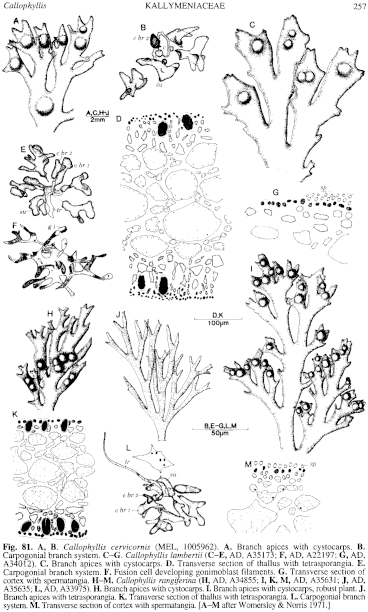|
|
|
|
|
|||||||||||
|
Electronic Flora of South Australia Species Fact Sheet
Phylum Rhodophyta – Class Florideophyceae – Order Gigartinales – Family Kallymeniaceae
Selected citations: Harvey 1863, synop.: xliii. Lucas & Perrin 1947: 158. Womersley 1950: 168. Womersley & Norris 1871: 33, figs 63, 64, 101.
Thallus (Fig. 80B) medium to dark red, 4–15 (–25) cm high, much divided in an irregularly lateral to subdichotomous manner, with branches mostly 1–3 mm broad; apices of branches (Fig. 81A) usually lanceolate and basally narrow, often shortly furcate and about 1 mm broad just behind the acute apices; branch margins smooth above, with few if any spinous or proliferous laterals, smooth to sparsely dentate in older parts; laterals often 1 cm or more apart; substance cartilaginous, usually not adhering to paper on drying. Holdfast discoid, 1–3 mm across; epilithic. Structure. Thallus mostly 300–500 µm thick, consisting of a medulla of medium to large subspherical to ovoid cells, the larger ones with thick walls, irregularly arranged, with intermixed filaments of relatively short cells (irregular in size but mostly 1–4 times as long as broad and 4–10 µm thick); larger medullary cells often circled or separated by a ring of small oval cells as seen in sectional view of thallus; cortex of several layers of ovoid to elongate cells, smaller outwards, with the outermost cells in surface view rounded to elongate, 3–6 µm across.
Reproduction: Carpogonial branch systems (Fig. 81B) formed in the outer medulla, about 50 µm across when mature, monocarpogonial with the supporting cell, first cell of the carpogonial branch and 1–3 subsidiary cells bearing one to several lobes and the second cell of the carpogonial branch ovoid. Carposporophyte with numerous groups of subspherical to ovoid carposporangia (10–17 µm long) separated by gonimoblast filaments; cystocarps 0.7–1.5 mm in diameter (Fig. 81A), slightly to moderately swollen and with a small ostiole, usually situated at the base of the furcations of a branch or near a short lateral, up to several millimetres from the apices. Male thalli unknown.
Probable tetrasporangial plant with tetrasporangia scattered in outer cortex, irregularly cruciately divided, 25–35 µm long by 18–25 µm broad.
Type from Encounter Bay, S. Aust.; holotype in MEL, 1005962.
Selected specimens: Elliston, S. Aust., drift (Womersley, 13.i.1951; AD, A13470). West Bay, Kangaroo I., S. Aust., drift (Womersley, 6.i.1946; AD, A3204). Pennington Bay, Kangaroo I., S. Aust., drift (Womersley, 4.i.1948, AD, A6639). Robe, S. Aust., drift (Womersley, 18.v.1964; AD, A27853). Nora Creina, S. Aust., drift (Gordon, 26.i.1967; AD, A31635). Warrnambool, Vic., drift (Womersley, 13.iv.1959; AD, A22929).
Distribution: Elliston, S. Aust., to Warrnambool, Vic.
Taxonomic notes: C. cervicornis is not a well-known species and distinctions between it and C. rangiferina are not always clear. Mature plants referred to C. cervicornis are, however, marked by the less profuse, more distant branching, smooth margins, distinctly lanceolate and basally constricted terminal segments, and cystocarps often more distant from the apices.
References:
HARVEY, W.H. (1863). Phycologia Australica. Vol. 5, Plates 241–300, synop., pp. i-lxxiii. (Reeve: London.)
LUCAS, A.H.S. & PERRIN, F. (1947). The Seaweeds of South Australia. Part 2. The Red Seaweeds. (Govt Printer: Adelaide.)
SONDER, O.W. (1853). Plantae Muellerianae. Algae. Linnaea 25, 657–709.
WOMERSLEY, H.B.S. (1950). The marine algae of Kangaroo Island. III. List of Species 1. Trans. R. Soc. S. Aust. 73, 137–197.
The Marine Benthic Flora of Southern Australia Part IIIA complete list of references.
Publication:
Womersley, H.B.S. (14 January, 1994)
The Marine Benthic Flora of Southern Australia
Rhodophyta. Part IIIA, Bangiophyceae and Florideophyceae (to Gigartinales)
Reproduced with permission from The Marine Benthic Flora of Southern Australia Part IIIA 1994, by H.B.S. Womersley. Australian Biological Resources Study, Canberra. Copyright Commonwealth of Australia.
Illustrations in Womersley Part IIIA, 1994: FIGS 80B, 81A, B.

Figure 80 enlarge
Fig. 80. A. Austrophyllis harveyana (MEL, 1005978). Habit. B. Callophyllis cervicornis (AD, A27853). Habit. C. Callophyllis lambertii (AD, A35173). Habit. D, E. Callophyllis rangiferina. (D, AD, A35635; E, AD, A34855). D. Habit. E. Transverse section of thallus and cystocarp. [A–E as in Womersley & Norris 1971.]

Figure 81 enlarge
Fig. 81. A, B. Callophyllis cervicornis (MEL, 1005962). A. Branch apices with cystocarps. B. Carpogonial branch system. C–G. Callophyllis lambertii (C–E, AD, A35173; F, AD, A22197; G, AD, A34012). C. Branch apices with cystocarps. D. Transverse section of thallus with tetrasporangia. E. Carpogonial branch system. F. Fusion cell developing gonimoblast filaments. G. Transverse section of cortex with spermatangia. H–M. Callophyllis rangiferina (H, AD, A34855; I, K, M, AD, A35631; J, AD, A35635; L, AD, A33975). H. Branch apices with cystocarps. I. Branch apices with cystocarps, robust plant. J. Branch apices with tetrasporangia. K. Transverse section of thallus with tetrasporangia. L. Carpogonial branch system. M. Transverse section of cortex with spermatangia. [A–M after Womersley & Norris 1971.]

|
Email Contact: State Herbarium of South Australia |

|